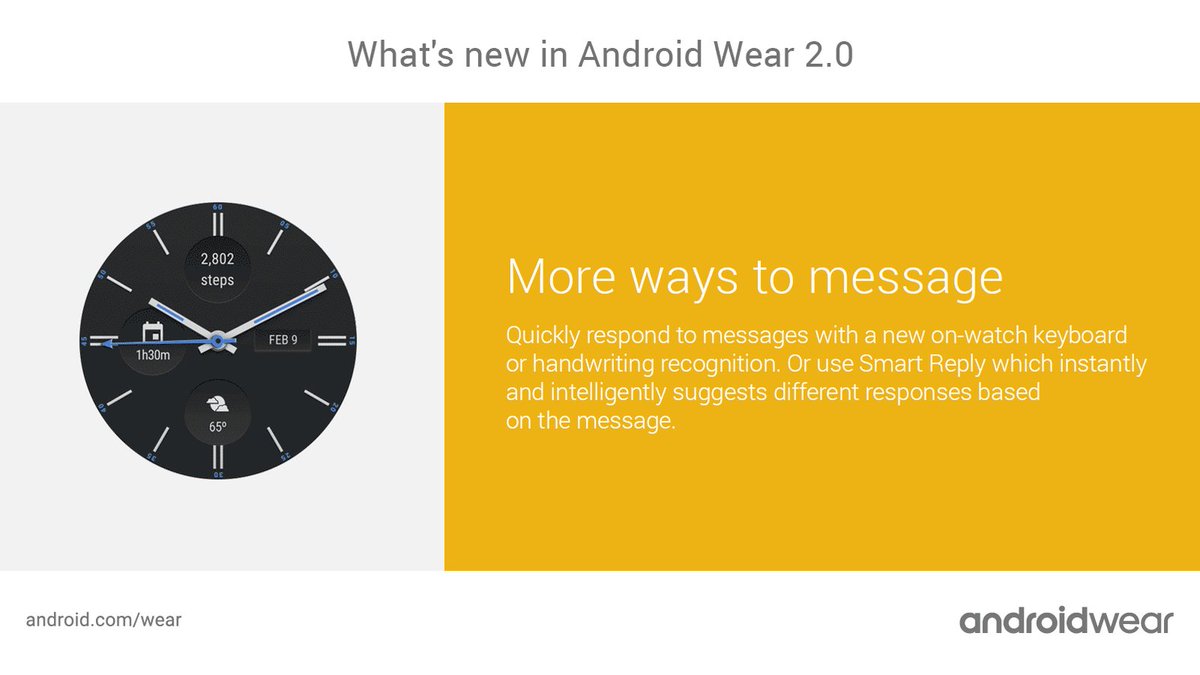Google has
launched Android Wear 2.0, the newest version that will power smartwatches. The upgrade was announced last year during Google I/O 2016 and the update is a few months late than what was originally planned. The company has not made any revolutionary changes to the smartwatch experience to change how we look at smartwatches. Instead, the company has added updates to many key components of the operating system which will enable faster access to the things that you performed on your Android Wear-powered smartwatch.

Image Credit: Google Android
Android Wear 1.0 was a bit complicated and most of the operations that you wanted to perform seemed more complex than they should be. Google focused on improving this by removing the complexity. The first important change that you will se is the presence of better Watch Faces and an easier way to change Watch Faces.

Image Credit: Google
Google has changed the fundamentals of watch faces by adding space to show information from the system as well as third-party apps like Uber, Nike and other fitness or weather apps. This is done by collecting the information using the
Complications API. The process to change Watch Faces is as easy as flicking left or right instead of long pressing on the screen to go to a screen where you can change the watch faces.

Image Credit: Google Android
The second most important improvement is the introduction of standalone apps that don’t need companion apps on your smartphone. You don’t need to install separate apps on your smartphone to help run the Android Wear apps. You can now access Google Play Store on the watch and install new apps without the need of a smartphone. The interface of Android Wear 2.0 is more in line with the Material design guidelines with more emphasis on cards where each notification will get a full screen for its expanded view.

Image Credit: Google
Another significant improvement is the addition of Android Pay to Android Wear 2.0. You can use your Android Wear 2.0 powered Smart watch to pay using Android Pay. One thing to note is that the smart watch should be equipped with NFC and your smartphone must have a locked bootloader.

Image Credit: Google
Google has improved other things like the Google Fit app for Google Android Wear where it now supports more type of workouts and exercises. One interesting thing to note is that Android Wear 2.0 comes with a keyboard to type your responses on. One would obviously not use that keyboard to write long articles or something huge in size. The major thing that makes the keyboard on Android Wear 2.0 significant is that you no longer need to swipe across a Qwerty layout screen to type a message. Instead, the keyboard is powered using the powerful prediction engine of Google Keyboard which works surprisingly well. You can also handwrite messages or use smart reply for Google Assistant.
Last but not the least, Google has added Google Assistant to Android Wear 2.0 making it a significant improvement over Android Wear 1.0 and Google Now. This is almost like Google Assistant on Google Home or Google Pixel smartphone. One thing to note is that Google has changed its philosophy after realising that one does need some physical input to operate Android Wear, making the presence of buttons and dials mandatory on the new models of watches; a far cry from what it was earlier.




















